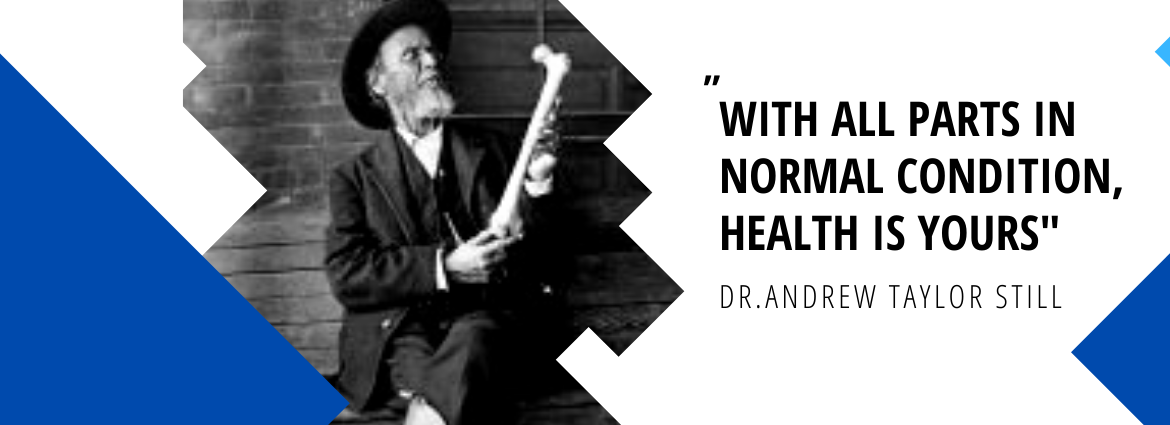Every cell in the body is connected to the rest by blood and by nerves. A cell receives nutrition, puts out its waste, and sends out signals for what it needs through arteries, veins and capillaries. For more urgent matters, like having stepped on a nail, it uses the nerves so that the rest of the body can react quickly through muscles to minimize the damage. Even eating the wrong thing with too much foreign bacteria can activate nerves along our digestive tract and trigger immediate emptying of the digestive system to protect the rest of the body. Our nervous system and cardiovascular system work together to ensure that every cell has what it needs to function at every moment. So what happens when something stops working?
In 1897, the founder of Osteopathy, Andrew Taylor Still wrote that he “looked upon disease as an abnormal condition, and reasoned that the means of restoring the normal should be in the human engine itself, not in some remote corner of the universe or hidden miles under the sea”.
Although this quote was written at a time where modern medicine had not yet made any significant breakthroughs, it was still as foreign to the culture of our western society then as it is now. Could the cause of ill health could be found from a restriction within the body; from isolating an area from the regular supply of blood and communication via nerves that it needs to be healthy?
Most approaches in health today look at the addition of things; supplementing the body with food, supplements, and medication, to build our health and prevent worse things from taking place, such as the potential death brought on by uncontrolled blood sugar. However, we seldom explore the concept that not getting enough of a certain nutrient/chemical could be caused by poor functioning of another body system. Could a disease of the nervous system could be caused by restrictions to the blood and nerves surrounding the liver, so that it becomes more difficult for it to remove toxins from the blood, and to create bile to absorb the necessary fat to create the myelin sheath that helps nerves relay signals quickly? I’m hypothesizing here, but it is a quick thought that underlines just how connected and dependent our body is on every other part of the body working well. Certainly with faulty genetics, an unhealthy environment or poor immunity, certain medications can be absolutely necessary, however Is it that much of a reach to think that a cell or a tissue’s failure to function could be the result of its environment?
When we look at pain/neuralgia in the leg or arm, it is common to relate those problems to joint issues in the low back or neck. We may get X-rays to determine if there is stenosis (loss of space between the vertebrae), or other tests to determine whether there is a bulging of the disc that is impinging on these nerves. However, we seldom place our hands on the low back or neck, or the area that isn’t working, to examine the ability of the associated joints to move freely, or the tension in the muscles/ligaments that may be restricting this movement.
It is not unique to only Osteopathy, the concept that any joint that is misaligned will create reflexive tension in the muscles in order to stabilize the area. This results in both an increased demand on the motor and sensory side of the nerves, and can create restriction to the associated blood vessels in that area of the spine. These problems, left too long, can certainly make it difficult for all tissues in the area to work well; the ligaments, muscles, bones, nerves and blood vessels may all undergo changes we may call ‘aging’. The result is pain/neuralgia. But what if we turned our eyes from the result to the removal of the cause? By relaxing the muscles and corresponding nerves, then moving to the sensory (proprioceptive) side of the problem by gently guiding that joint through normal motion, could we, in time, remove that irritation, improve blood flow, and bring health back to the area? What if the irritation was instead located in the spaces between the organs of the abdomen? A manual osteopath with a sense of anatomy and adequate palpation skills is well aware of areas with large concentrations of nerves and an approximate idea of where they are located in the abdomen. By working on the sensory side, could inhibiting these nerves (or stimulating the vagus nerve), restore normal tension in the area and free up the communication between these organs?
These are some the many questions I carried into the beginning of my manual osteopathic career. I had many doubts, especially considering the practice is still quite obscure even 125 years after its beginning. However, through sticking to the anatomy and focusing on each unique case that came into my office, it has been rare not to find some sort of improvement in the health of that individual with treatment, even in cases which may be beyond the body’s capacity to heal completely. If given enough time, even some very advanced cases can be significantly helped: pain relief, improved mobility, better sleep and better digestion are many of the reported outcomes. Side effects are usually minimal, some minor discomfort in the days following treatment. A safe, gentle manipulative treatment that helps the body work freely, without ever having to force muscles or joints into place.
Through my personal experience, I can find few arguments against the founder of Osteopathy, AT Still, when he wrote, “[Osteopathy] has searched man himself for the means of controlling disease, and he has been rewarded for discovering that the great Machinist placed within the human body everything necessary to run it smoothly.”
Improving health from the inside out, it’s certainly worth a shot.

